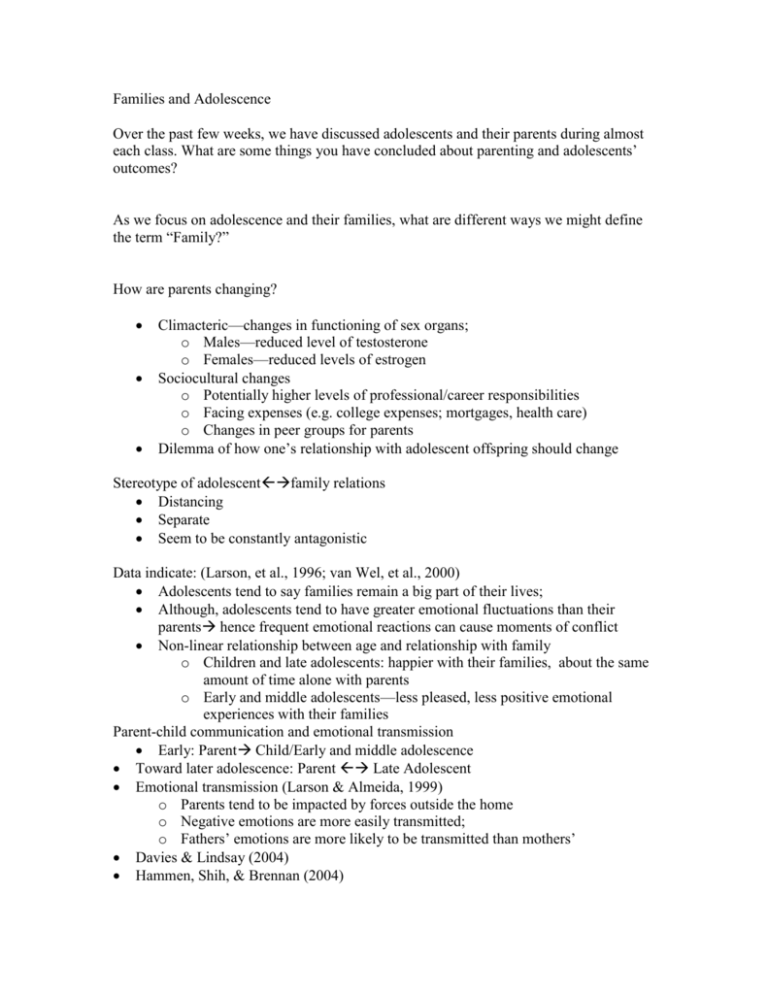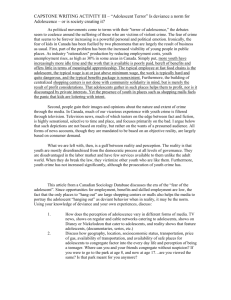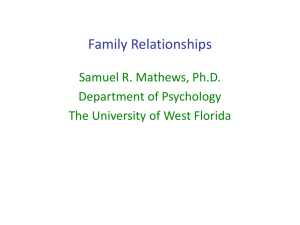Families and Adolescence
advertisement

Families and Adolescence Over the past few weeks, we have discussed adolescents and their parents during almost each class. What are some things you have concluded about parenting and adolescents’ outcomes? As we focus on adolescence and their families, what are different ways we might define the term “Family?” How are parents changing? Climacteric—changes in functioning of sex organs; o Males—reduced level of testosterone o Females—reduced levels of estrogen Sociocultural changes o Potentially higher levels of professional/career responsibilities o Facing expenses (e.g. college expenses; mortgages, health care) o Changes in peer groups for parents Dilemma of how one’s relationship with adolescent offspring should change Stereotype of adolescentfamily relations Distancing Separate Seem to be constantly antagonistic Data indicate: (Larson, et al., 1996; van Wel, et al., 2000) Adolescents tend to say families remain a big part of their lives; Although, adolescents tend to have greater emotional fluctuations than their parents hence frequent emotional reactions can cause moments of conflict Non-linear relationship between age and relationship with family o Children and late adolescents: happier with their families, about the same amount of time alone with parents o Early and middle adolescents—less pleased, less positive emotional experiences with their families Parent-child communication and emotional transmission Early: Parent Child/Early and middle adolescence Toward later adolescence: Parent Late Adolescent Emotional transmission (Larson & Almeida, 1999) o Parents tend to be impacted by forces outside the home o Negative emotions are more easily transmitted; o Fathers’ emotions are more likely to be transmitted than mothers’ Davies & Lindsay (2004) Hammen, Shih, & Brennan (2004) Parenting Styles: Diana Baumrind: Two dimensions— o Responsiveness—warmth, caring, sensitive, supportive o Demandingness—expectations, supervising, monitoring o Authoritarian: Low responsiveness High demandingness Parenting behaviors: Likelihood of high levels of punitive actions (corporal punishment, severe sanctions against infractions) High expectations Low support Little involvement in family decisions Decisions are not open to discussion Rationales are not provided Outcomes Rigid Lack problem-solving skills Tend to turn to peers for support and information Likely not eager to make difficult decisions o Premissive—Indulgent High responsiveness Low demandingness Parenting behaviors: Attempts to respond positively to every request made by the adolescent Few rules or boundaries Attempts to control adolescents’ behavior are grounded in reason with little or no consequences for less than favorable conduct Adolescent is not accountable for behavioral outcomes Adolescent is an active and frequently equal participant in family decisions and frequently decisions are based on adolescents’ own perspectives Inappropriately involves adolescent in parental lives Outcomes Poor emotional control Low persistence to difficult or unpopular tasks Frequent externalizing behavior when desires are denied Poor decision-making skills Blurred boundaries between adolescent and parent (e.g. adults may engage in adolescent behavior to show closeness—adolescent does not recognize boundaries) o Neglectful—Indifferent Low responsiveness Low demandingness Parenting behaviors Inconsistent discipline based on impact of behavior on parents’ own activities and preferences Few rules or boundaries Punishment, when given, can be harsh Low parental monitoring Outcomes Low levels of performance in social and academic domains, and frequently poor emotional control Typically lacks clear understanding of contingency of outcomes on behaviors (little link between behavior and outcome) May seek out peers for support with little attention to norms of the peer group o Authoritative High responsiveness High demandingness Parenting behaviors Sets consistent and reasonable boundaries for adolescents’ behaviors Uses reason and discussion as first option for discipline Low-to-no use of corporal punishment Models civil discussion Monitors adolescents’ behaviors, peers, etc., Allows adolescents’ involvement in family decisions where appropriate Maintains parental role with little or no enmeshment Outcomes Higher levels of achievement in social and academic domains Recognizes relationship between behaviors and outcomes—understands contingencies Adaptive level of emotional control Develops adaptive decision-making skills Lower levels of psychological distress (e.g. stress, anxiety, depression) Sandra Scarr—“just good enough parenting” Beyond a certain level of nurturing, little is gained relative to other forces outside the family (genetics, peers, other institutions). Genotype-Environment interaction types: o Passive: genetic contributors (parents) also structure the environment hence, phenotypic expression typically fits the constructed environment o Evocative: child’s and adolescent’s actions and demeanor elicit from others responses that reinforce or extinguish those behaviors o Active: adolescents select those environments that provide a maximum fit with actions and demeanors. o The point is that parents do have roles in their children’s lives….but at some point the impact diminishes Family Paradigm: Basic beliefs about the environment—hostile/chaotic or orderly/predictable Key is in how families solve problems or make decisions o Problem analysis (as opposed to perseveration or emotion focused) o Cooperative/Working Together (as opposed to independently approaching the problem) Wkng Togthr High Low Family Paradigm Problem Analysis High Low Multiple plausible solutions Focus is on affective responses not on problem Independent Little activity with exploration little of options interaction and little interactions











